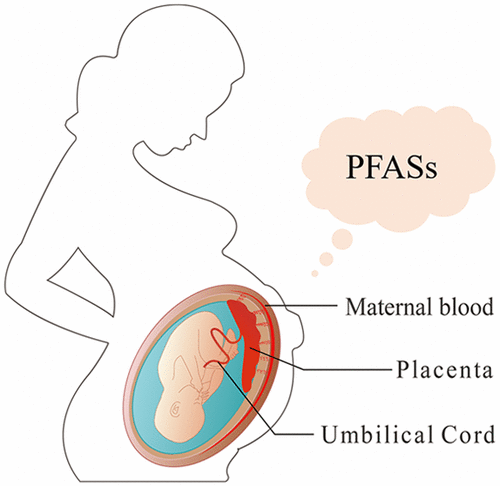当前位置:
X-MOL 学术
›
Environ. Sci. Technol.
›
论文详情
Our official English website, www.x-mol.net, welcomes your
feedback! (Note: you will need to create a separate account there.)
A Critical Review on Transplacental Transfer of Per- and Polyfluoroalkyl Substances: Prenatal Exposure Levels, Characteristics, and Mechanisms
Environmental Science & Technology ( IF 10.8 ) Pub Date : 2021-06-18 , DOI: 10.1021/acs.est.1c01057 Donghui Ma 1, 2 , Yao Lu 1, 2 , Yong Liang 3 , Ting Ruan 1 , Juan Li 1 , Chunyan Zhao 4 , Yawei Wang 1, 2, 3 , Guibin Jiang 1, 2
Environmental Science & Technology ( IF 10.8 ) Pub Date : 2021-06-18 , DOI: 10.1021/acs.est.1c01057 Donghui Ma 1, 2 , Yao Lu 1, 2 , Yong Liang 3 , Ting Ruan 1 , Juan Li 1 , Chunyan Zhao 4 , Yawei Wang 1, 2, 3 , Guibin Jiang 1, 2
Affiliation

|
Prenatal exposure to perfluoroalkyl and polyfluoroalkyl substances (PFASs) has aroused public concerns as it can pose multiple health threats to pregnant women and cause adverse birth outcomes for fetuses. In previous studies, the prenatal exposure levels and transplacental transfer efficiencies (TTE) of PFASs have been reported and discussed. Specifically, the binding affinities between PFASs and some transporters were determined, demonstrating that the TTE values of PFASs are highly dependent on their binding behaviors. To summarize primary findings of previous studies and propose potential guidance for future research, this article provides a systematic overview on levels and characteristics of prenatal exposure to PFASs worldwide, summarizes relationships between TTE values and structures of PFASs, and discusses possible transplacental transfer mechanisms, especially for the combination between PFASs and transporters. Given the critical roles of transporters in the transplacental transfer of PFASs, we conducted molecular docking to further clarify the binding behaviors between PFASs and the selected transporters. We proposed that the machine learning can be a superior method to predict and reveal behaviors and mechanisms of the transplacental transfer of PFASs. In total, this is the first review providing a comprehensive overview on the prenatal exposure levels and transplacental transfer mechanisms of PFASs.
中文翻译:

全氟和多氟烷基物质经胎盘转移的批判性评论:产前暴露水平、特征和机制
产前暴露于全氟烷基和多氟烷基物质 (PFAS) 引起了公众的关注,因为它可能对孕妇构成多种健康威胁,并对胎儿造成不利的分娩结果。在以前的研究中,已经报道和讨论了 PFAS 的产前暴露水平和经胎盘转移效率 (TTE)。具体而言,确定了 PFAS 与一些转运蛋白之间的结合亲和力,表明 PFAS 的 TTE 值高度依赖于它们的结合行为。为了总结以往研究的主要发现并为未来研究提出潜在指导,本文系统地概述了全球产前暴露于 PFASs 的水平和特征,总结了 TTE 值与 PFASs 结构之间的关系,并讨论了可能的经胎盘转移机制,特别是对于 PFAS 和转运蛋白之间的组合。鉴于转运蛋白在 PFAS 经胎盘转移中的关键作用,我们进行了分子对接以进一步阐明 PFAS 与所选转运蛋白之间的结合行为。我们提出机器学习可以成为预测和揭示 PFAS 经胎盘转移的行为和机制的优越方法。总的来说,这是第一次全面概述 PFAS 的产前暴露水平和经胎盘转移机制。我们进行了分子对接,以进一步阐明 PFAS 与所选转运蛋白之间的结合行为。我们提出机器学习可以成为预测和揭示 PFAS 经胎盘转移的行为和机制的优越方法。总的来说,这是第一次全面概述 PFAS 的产前暴露水平和经胎盘转移机制。我们进行了分子对接,以进一步阐明 PFAS 与所选转运蛋白之间的结合行为。我们提出机器学习可以成为预测和揭示 PFAS 经胎盘转移的行为和机制的优越方法。总的来说,这是第一次全面概述 PFAS 的产前暴露水平和经胎盘转移机制。
更新日期:2021-06-18
中文翻译:

全氟和多氟烷基物质经胎盘转移的批判性评论:产前暴露水平、特征和机制
产前暴露于全氟烷基和多氟烷基物质 (PFAS) 引起了公众的关注,因为它可能对孕妇构成多种健康威胁,并对胎儿造成不利的分娩结果。在以前的研究中,已经报道和讨论了 PFAS 的产前暴露水平和经胎盘转移效率 (TTE)。具体而言,确定了 PFAS 与一些转运蛋白之间的结合亲和力,表明 PFAS 的 TTE 值高度依赖于它们的结合行为。为了总结以往研究的主要发现并为未来研究提出潜在指导,本文系统地概述了全球产前暴露于 PFASs 的水平和特征,总结了 TTE 值与 PFASs 结构之间的关系,并讨论了可能的经胎盘转移机制,特别是对于 PFAS 和转运蛋白之间的组合。鉴于转运蛋白在 PFAS 经胎盘转移中的关键作用,我们进行了分子对接以进一步阐明 PFAS 与所选转运蛋白之间的结合行为。我们提出机器学习可以成为预测和揭示 PFAS 经胎盘转移的行为和机制的优越方法。总的来说,这是第一次全面概述 PFAS 的产前暴露水平和经胎盘转移机制。我们进行了分子对接,以进一步阐明 PFAS 与所选转运蛋白之间的结合行为。我们提出机器学习可以成为预测和揭示 PFAS 经胎盘转移的行为和机制的优越方法。总的来说,这是第一次全面概述 PFAS 的产前暴露水平和经胎盘转移机制。我们进行了分子对接,以进一步阐明 PFAS 与所选转运蛋白之间的结合行为。我们提出机器学习可以成为预测和揭示 PFAS 经胎盘转移的行为和机制的优越方法。总的来说,这是第一次全面概述 PFAS 的产前暴露水平和经胎盘转移机制。


















































 京公网安备 11010802027423号
京公网安备 11010802027423号